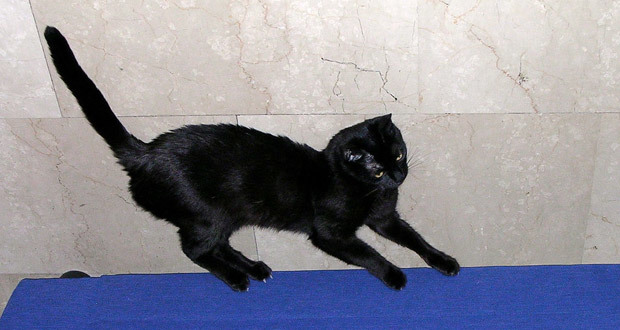Make their scratching spots unpleasant and deterring

Photo: Mr.TinDC (CC BY-ND 2.0)
You can deter your cat from scratching by making it into an unpleasant activity, if it is no longer enjoyable they will likely stop quickly. You can do this by utilizing tapes and sprays. Start by making the spots you don’t want your cat to scratch less enticing to them. Upholstered chairs and couches might as well be a magnet attracting your cat to start scratching. You can easily make them less appealing by applying a simple herbal spray that has cat deterring scents in it, or applying double sided tape. The herbal sprays replace your cat’s territorial markers that they leave behind when they scratch and leave a scent that is unappealing to them in its stead.
Cats’ paws are very sensitive to the touch since they have evolved to detect the vibrations caused by their prey as they rustle the leaves and brush. This very sensitivity can work greatly to your advantage however, the double sided tape makes the surfaces very annoying to your cat and they are likely to avoid scratching at any place that is so unappealing. Both options are subtle, nearly undetectable by the human eye, yet still yield results.
Effective and best long run solution

Photo: Jennifer C. (CC BY 2.0)
If you haven’t designated a specialized place for your cat to do its scratching, then you can hardly blame them for attacking your furniture. Scratching is instinctual behavior for cats, but if you displace your cat’s attentions, then you may just save your furniture. You can do this by providing a more inviting alternative and introducing your cat to it. Offering your pet a cat scratching post, furniture designed especially for cats or even a board, you will soon find that your cat is content to scratch there.
If the problem area where your cat likes to scratch is at a doorframe or something like the wooden leg of a desk, then a cat post or piece of furniture made of cedar may be best. However if your cat loves to pounce, scratch and shred the soft side of your couch or your lovely area rug, then a cat tree or perch that is carpeted may be just the ticket for keeping them occupied. Sisal, which is a tough, rough marine grade type of rope is a favorite of many felines, you can utilize it on a vertical post or a cat tree. Regardless of what option you are offering to your cat, a spray of catnip will greatly encourage them to head to that area.
Immediate solution your feline pet might not like

Photo: Jacob Davies (CC BY-SA 2.0)
Finally, you can dull your cat’s nails to mitigate the damages. Trimming their nails regularly is the most effective way to negate the amount of damages that scratching can cause your furniture, rugs and door frames. Utilize a veterinary quality set of clippers, you simply lightly squeeze your cat’s paw to expose their retractable claws. If they react negatively, you may want to wrap them in a towel while you do this. There is another way as well, there are several kinds of »nail caps« that glue on the ends of your cats nails and will stay on for a month or longer and do not interfere with your cats claw retraction.
When you find your nerves and furniture becoming frayed from a nuisance cat, just recall the three D’s to help with the problem. Show your pet the alternatives you have provided and shower them with rewards and praise for using them.
 Cat On The Web
Cat On The Web





